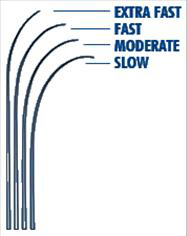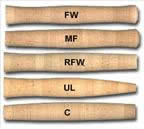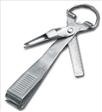

FLY FISHING EQUIPMENT FOR LARGEMOUTH BASS
"If people concentrated on the really important things in life, there'd
be a shortage of fishing poles."
- Doug Larsen
There are shoppers and there are buyers. I know a woman who can stand for
a half-hour before a sales shelf that contains only ten items, deciding. In
a perfect world there would be more than one store and more than ten items,
but as a fly fisherman I can tell you, for every city that I have ever visited
where fly fishing equipment is sold – that the choices there are limited to
one. For decades, fly fishermen suffered the woes of the red-headed step child,
watching fishing stores pander to spin casters, level winders and cane polers
and then there was the Internet. The end of this article lists major Internet
and catalog sources for fly fishing equipment. Today, thanks to computer technology,
before the first fly hits the water the bass fly fisherman must choose from
a bewildering array of equipment. Hallelujah! Now, how much to spend?

RODS: Experts debate over the optimal set-up to use for bass. Catching
a bass on a 7 ½ foot 3 wt. system is exhilarating but nerve wracking, and
catching one on a 10 weight system is a bit like using a tow truck. In years
past, fly rods were made shorter (6'-8'), due to the heavy blank materials,
but with today's ultra-light graphite/boron construction used in the vast
majority of rods, lengths can be longer (8 ½ -9') with the weight being kept
to a minimum and still deliver good action. Action (or flex) of the fly rod
describes the bend in the rod when "loaded" during the cast. Rods
are either “fast action” (tip flex), “mid action” (mid flex), or “slow action”
(full flex). The stiffer the fly rod the more muscle it takes on the part
of the fisherman, but stiffness helps generate more line speed during the
cast making for a longer and more powerful cast. A medium action rod will
bend from the top third to middle of the rod upward (top half) to the tip
of the rod. The lower half of the fly rod, nearest the grip, will basically
remain stiff. Medium action fly rods have enough backbone to be powerful but
are generally forgiving because they generate slower line speed that gives
more control and provide a mechanical assist in casting because of rod action
in recovering from the flex. A slow action rod is very flexible. A slow action
rod will bend for most of its length and are intended for short, accurate
and gentle casts. Slow action rods help protect light tippets by absorbing
the shock of a strike or hook set. For most bassing situations (because you
don’t want to be standing on top of the fish), a longer somewhat stiffer rod
is better; it provides more distance when casting, better line controlling
abilities and better line mending. While there are exceptions, 8 ½ feet is
a good all-around length. Obviously, for certain situations, shorter rods
are useful (heavy cypress overhead cover and small narrow creeks) and the
more a fisherman tends to use small insect imitations, the more comfortable
that lighter and slower action equipment will be.
All rod manufactures print a rating on the rod just above the reel seat. This
#rating tells you what weight line will work best with that particular rod.
Using the wrong weight line makes casting difficult or impossible if severely
mismatched. The #rating is known as the AFTM (Association of Fishing Tackle
Manufactures) number. The lighter the system, the better reflex, responsiveness
and sensitivity the rod will need, which ultimately means more money. Conversely,
the more the fisherman tends to throw flies the size of a sparrow, the more
comfortable he may be with heavier equipment and stiffer rods. Interestingly,
stiff rods are deceptive and many fishermen cannot distinguish one fast action
rod from another except by overall weight of the rod, which means a preference
for fast rods may suggest it is worthwhile buying a cheaper system. But take
care, a day on the water with a heavy fast action rod and your shoulder will
remember it the next day. Carrying two rods to bassing waters is highly recommended,
but after a few hundred casts with a 4 wt., moving to a stiffer 8 wt. may
feel like you’ve traded a toothpick for a telephone pole. The best choice
is to take a pair of similar rods, preferably an 8 ½ -9', mid-flex 6/7 wt.
rod. Fortunately, this is the most common (i.e. easily available) rod.

NOTE: In choosing a rod, the style of rod grip is sometimes an option. Grips
come in five basic shapes as shown by the illustration: the full wells (FW),
the half-wells or western (MF), the reverse half-wells (RFW), the ultra fine
(UL) or the cigar shape (C). While the grip has the least amount of affect
on the performance of the rod - it does make a difference between enjoying
a day casting and one that is uncomfortable. If you have a choice, select
a grip that fits your casting style and hand size for the best performance,
but keep in mind, fuller grips perform better for long, powerful casts with
heavy rods, while lighter, thinner grips are the preferred choice for shorter
casts and more accurate, delicate presentations with lighter rods. The full
wells and half-wells are generally preferred for anything other than insect
patterns. If you are going traveling by air or in a mid-size or smaller car, do
not consider a 2 piece rod. Many excellent (and easily packed) 4 to7 piece
rods are available, and with the advancements in rod material and ferrule
technology, multi-piece rods are as efficient as a two piece and are available
in several price ranges.
REELS: There is little need for an expensive reel to bass fish. A top-of-the-line
may look pretty, but bass rarely get “on the reel” and the reel primarily
serves as a repository for line. A bass fisherman may never see his backing
exposed. Consequently, cheap reels are fine as long as the weight of the reel
doesn’t adversely affect the balance of the rod. Rod/reel combos are sold
matched for balance but you want to pay for rod quality not reel cost. Note
also that some reels have very loud clicker drags that can be irritating.
Reliable choices in aluminum reels are the Hobbs Creek Large Arbor from www.bass-pro.com
at $40 or the Prestige Plus from www.cabelas.com also $40.

LINE: It is worth paying for good line. Most bass fishermen use WFF
(weight forward floating) bass taper line matched to the rod’s #rating (or
a size up from the # rating) to throw larger flies. They will use double taper
(DT) or WFF of a size matched to the rod’s #rating to throw insect replica
flies. Double taper line is cheaper and is supposed to roll cast easier, but
is often not capable of turning over larger flies. Some bass flies throw like
kites and where the casting technique may fail, the line taper and heavier
line can compensate. However, fishing a cypress forest rarely allows for a
backcast and the need to curl a low roll cast around a log or under an overhanging
branch is not unusual. In this instance a double taper line may be the best
choice. The fisherman carrying two rods of similar weight would do well to
have a DT on one and a WFF on the other. Sink tip lines are unnecessary in
shallow lakes and should be kept on an extra spool.

LEADER & TIPPET: should be comparatively short and heavy. Bass
are reactive predators and rarely notice monofilament. (Consider that using
10 pound test leader will be almost half the line diameter of a conventional
bass fishermen’s line.) A 2-3' section of 20-30 pound test monofilament should
form the but section (attached to the fly line with a nail or nail-less nail
knot https://www.fishandfly.co.uk/knots/nless/index.html ). Next, a 3-4' length
of 6-12 pound test monofilament finishes the leader/tippet. That’s it. Short
and simple. No graduated taper is required. The larger the fly the heavier
the mono tippet should be which will assist in turning over larger flies.
Insect replicas will rarely be smaller than size 12, which works fine with
6 pound test tippet, but big bass are known to snap anything less than 10
without trying hard. For subsurface flies, fluorocarbon tippet has better
sink rates for a cost ($7-$13 when sold as a 30 yd. tippet spool) ten times
that of standard monofilament. While some folks think this might be a wasted
expense for bass, tests have shown that fluorocarbon Vanish ($9/250 yds/6#
test) is practically invisible in the water, slightly ahead of Trilene Clear
XL ($5/330 yds/6# test). Buy a regular spool of Vanish, it will last you and
all your friends for a year.

MORE KNOTS: There’s not much argument in this arena. For joining the butt
section to the much smaller tippet, a double surgeon’s knot https://www.netknots.com/html/fishing_knots.html
is traditional, functional and easy but not necessarily a fisherman’s best
choice. Try instead using a blood knot or double uni-knot https://www.netknots.com/html/fishing_knots.html
or double pitzen knot https://www.pechetruite.com/Noeuds/hook2.htm which are
smoother and more reliable. To tie on large flies with a large hook eye, a
Palomar knot https://www.go4bass.com/palomar.html is the best choice. For smaller
flies the pitzen is again a good choice. A tool called a “Tie-Fast” is frowned
upon by fly fishing purists, but helps immensely in tying complex knots (especially
nail-less nail knots and double uni-knots). A line-clipper/Tie-fast combo
is available and very convenient for$13. Go to www.cabelas.com (search for
“Tie-fast”).
Please note that each of the knot tying Internet sites will have many knots described. The ones shown are believed to be the easiest to follow for a particular knot.
[ HOME ]
[ Search ] [ Contact FAOL ] [ Media Kit ]